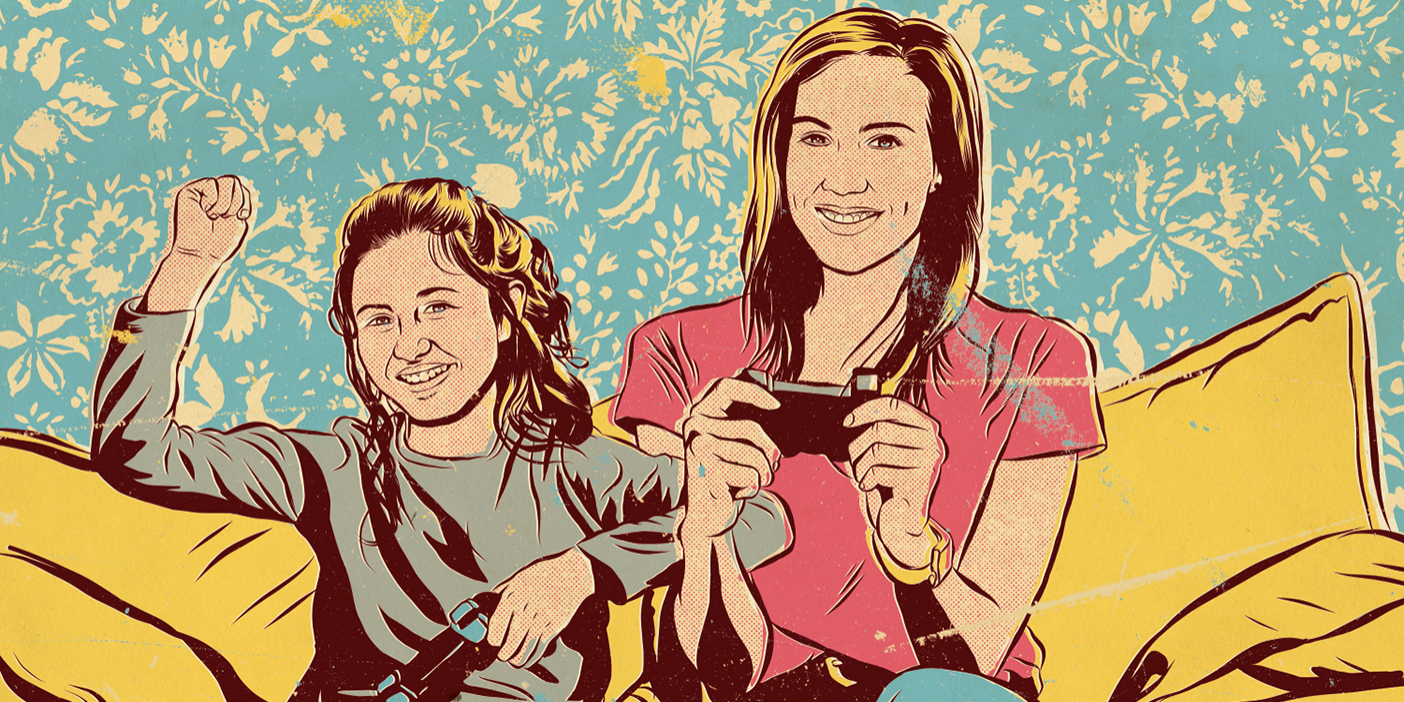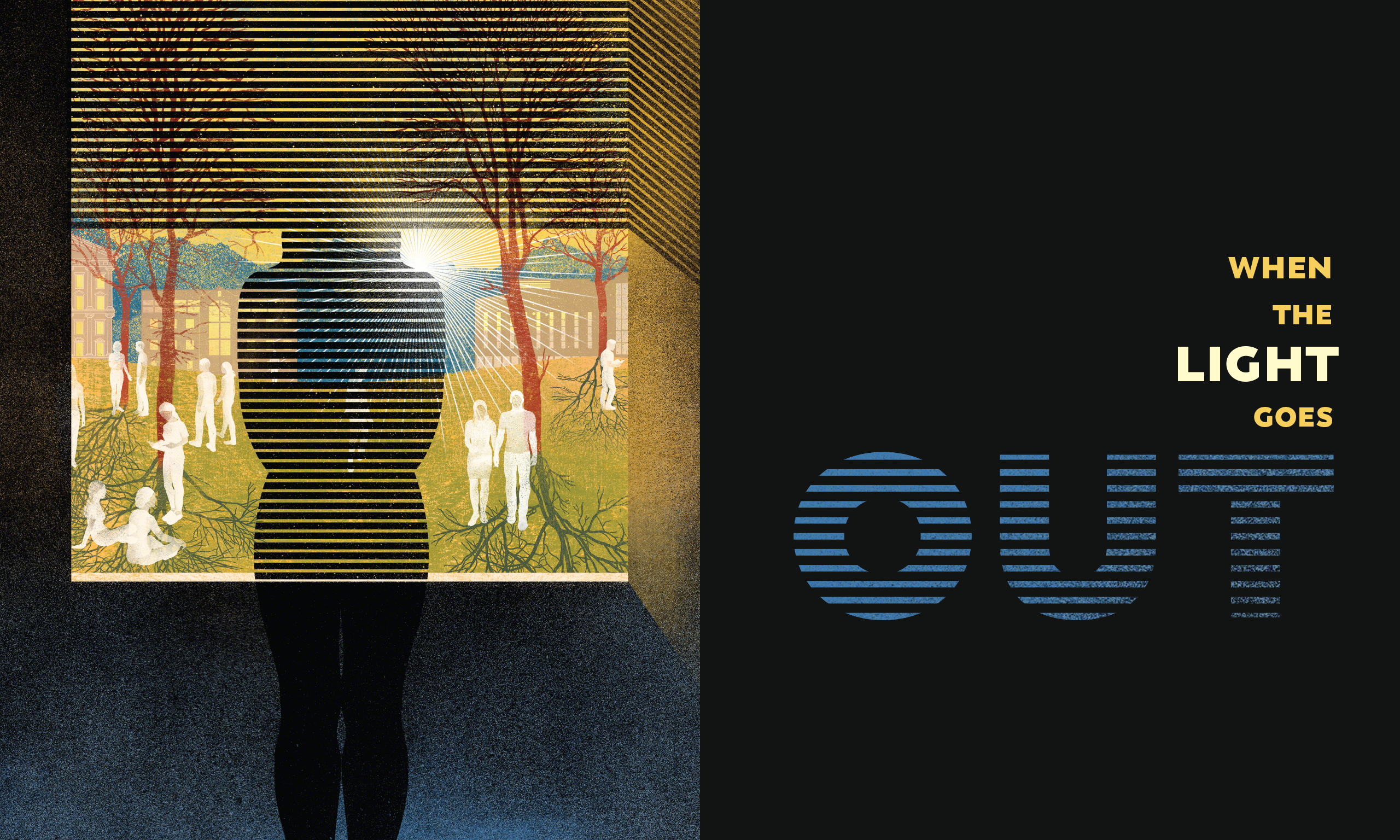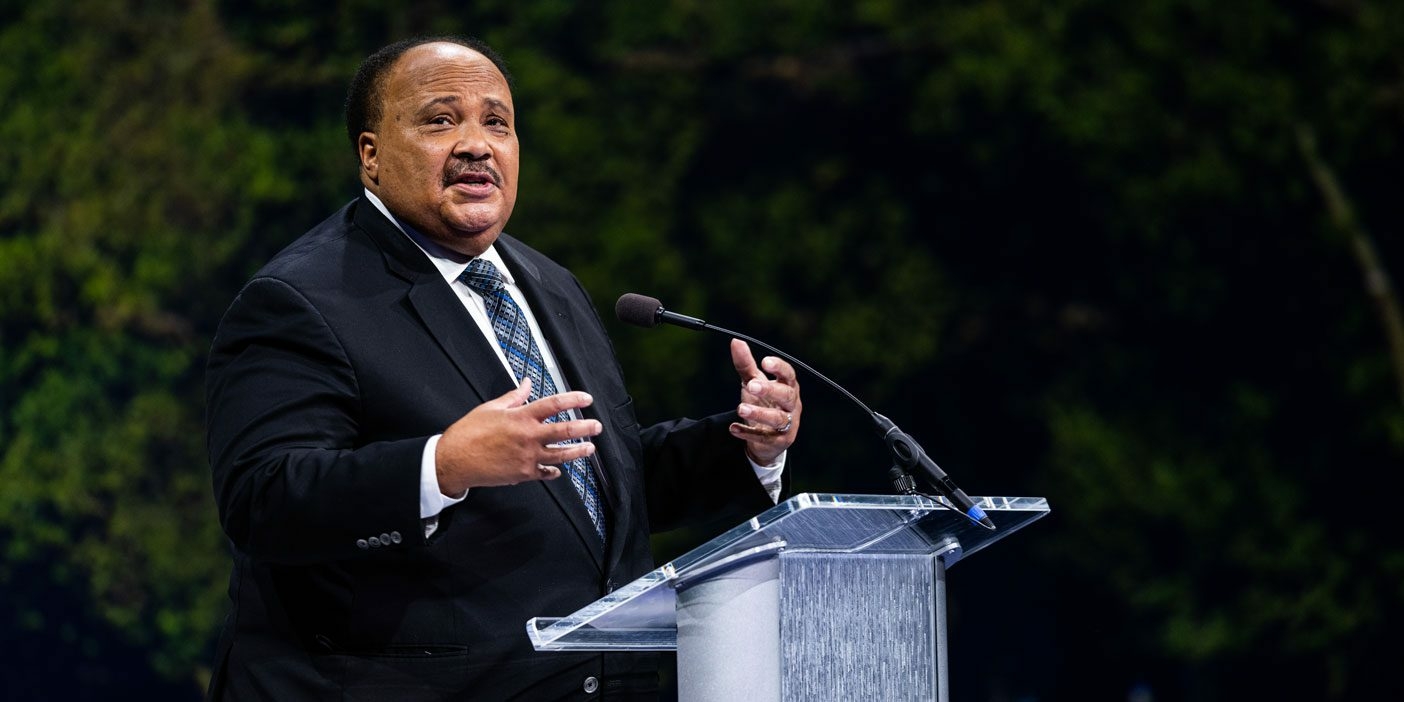The Bright Side
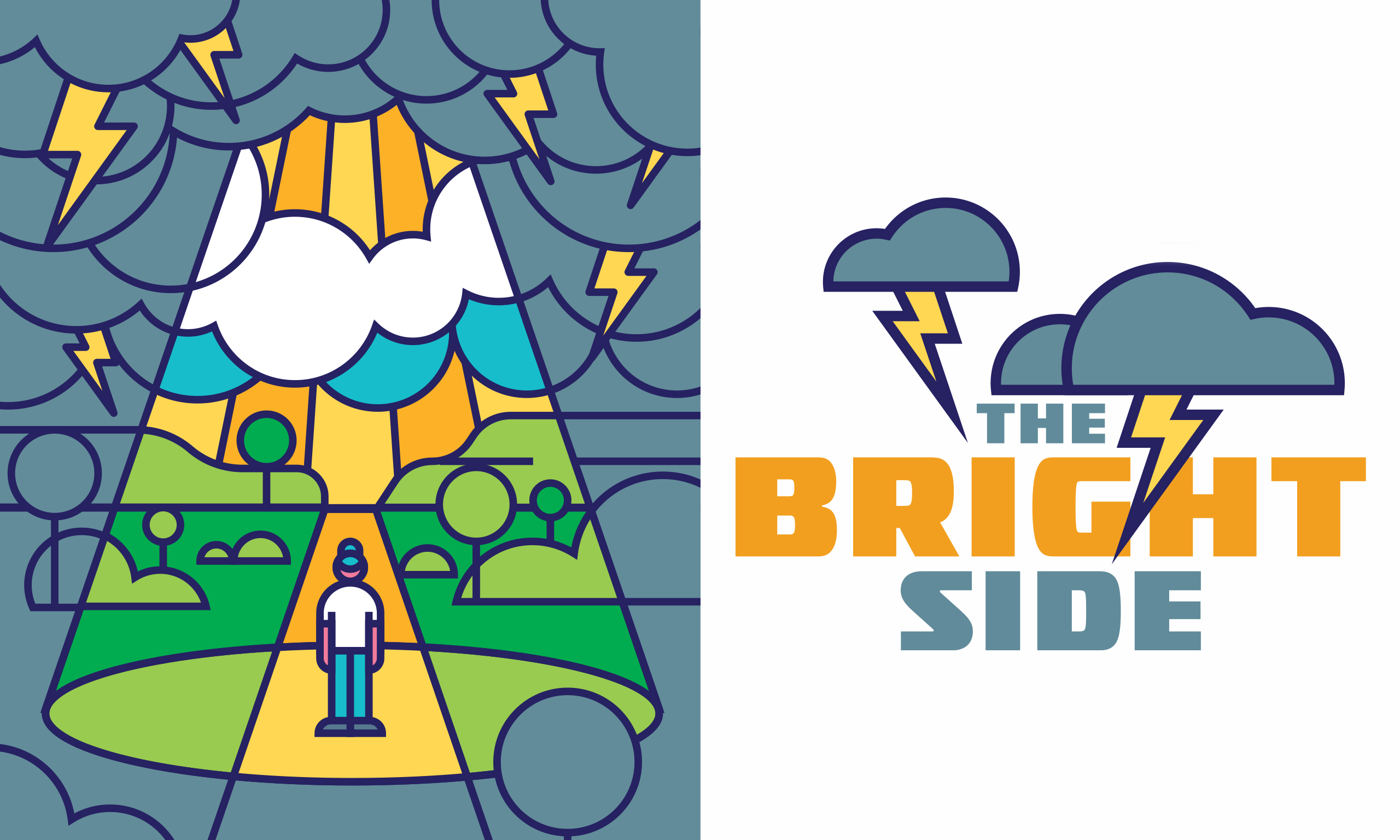
Yeah, times are tough, but should we despair? BYU experts share reasons why they’re hopeful for better days to come.
By Peter B. Gardner (BA ’08, MA ’04) and Sara Smith Atwood (BA ’10, MA ’15) in the Winter 2022 Issue
Illustrated by Hylton Warburton
BYU environmental scientist Benjamin W. Abbott understands the dangers posed by pollution and climate change better than most. The assistant professor of ecosystem ecology researches how human activity influences the environment, particularly water. But you won’t find him scowling or wagging his finger. It’s just not the vibe of the smiling, mile-a-minute-speaking scholar. Even as he acknowledges “existential threats” posed by rising temps and seas, there’s nothing doomy or gloomy in his tone.
For one thing, he’s not so sure shrill lectures motivate real change among the competing camps. “Sometimes,” he says, “we’re in a state of denial, like, ‘Oh no. It can’t be that bad.’ But then sometimes we switch straight to a state of despondency—‘Oh no. It’s too late. There’s nothing we can do.’ What those two positions have in common is they don’t require us to do anything.”
The truth is, Abbott says, recent scientific breakthroughs, combined with strategic policy and consumer cooperation, are putting real—read, not Pollyanna-ish—hopes of clearer skies and cleaner water within our grasp (see “Are We Toast?” below).
Despite our current hyperawareness of all that ails us, Abbott and other BYU experts say there are legitimate reasons for hope on problems ranging from food scarcity and poverty to mental health and cancer treatments. They, with colleagues around the world, are chipping away at these and other tough problems facing humanity.
Here 11 BYU experts share developments in their fields that give them hope for better days to come.
Food for All
Hope for Food Security
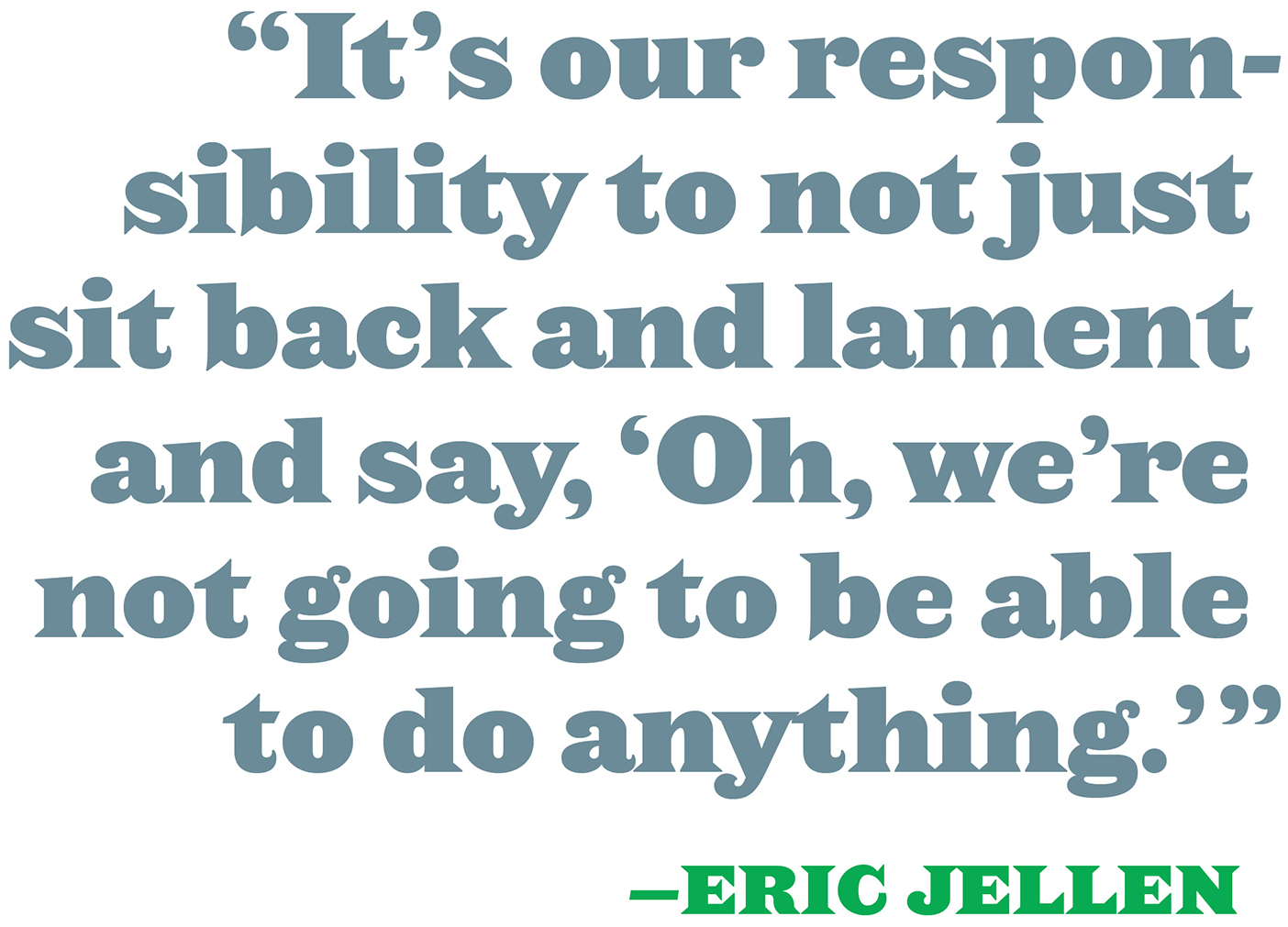
“I’m totally optimistic,” says BYU plant geneticist Eric N. Jellen (BS ’86) when it comes to the future of food security. He collaborates with researchers around the world to crossbreed protein-rich domesticated quinoa with wild varieties that can flourish just about anywhere. In another project, his BYU team is developing a high-protein oat variety with collaborators in Morocco.
Despite uncertainty about what climate change will mean for everything from weather patterns to weed control, Jellen says plant scientists won’t be caught off guard. They have new technologies like gene editing and precision farming at their disposal as they prepare. “I believe that technology comes to humanity by divine revelation,” he says. “It’s our responsibility to not just sit back and lament and say, ‘Oh, we’re not going to be able to do anything.’ . . . We need to get off our rears and be actively engaged in trying to alleviate human suffering.”
You Got This
Hope for Mental Health
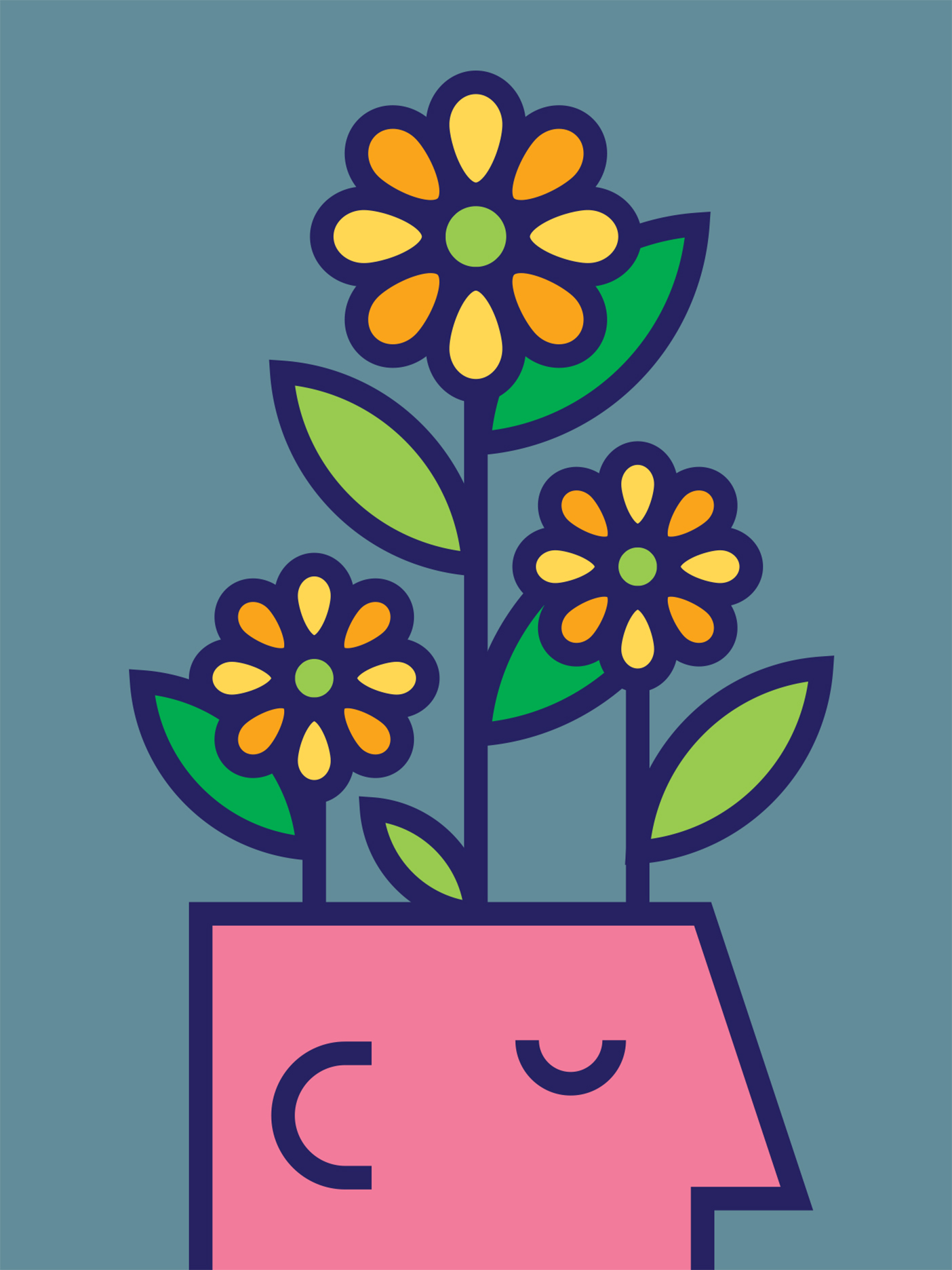
As a clinical psychologist and the executive director of BYU’s Student Development Services, Kara I. Cattani (BS ’96) says trends during COVID have been unmistakable—many more young people are experiencing mental hardship. But she derives hope from a parallel phenomenon: increased displays of resilience as those same people have adjusted to a changing world. “I have been so impressed,” she says, “watching students learn to be more independent and take ownership of their learning.”
The pandemic has given Cattani a new perspective on resilience. More than just the ability to push aside pain and bounce back, resilience, she says, “includes an ability to notice and sit with pain”—to learn from it. “We have a better chance of moving toward growth . . . when we get curious about our struggle,” she says. “Strength and struggle, as it turns out, sit side by side.”

Everyone’s Work
Hope for Racial Harmony
As the United States reckons with cultural and institutional racism, law professor Michalyn Steele (BA ’92, MA ’94), a member of BYU’s Committee on Race, Equity, and Belonging (CoREB), has seen encouraging improvements. “People are taking the initiative to do good on their own,” she says.
She points to one example in her own college: the BYU Law School formed a committee to discuss implementing recommendations from the CoREB report on making campus more inclusive. Steele, a member of the Seneca Nation of Indians of New York, applauded the Law School’s efforts “to bring everyone into this transformative effort.
“The temptation has been to outsource issues of diversity and belonging to people of color,” she says. “When I see people take responsibility for their part, that makes me hopeful—I see the work of belonging becoming everyone’s work.”
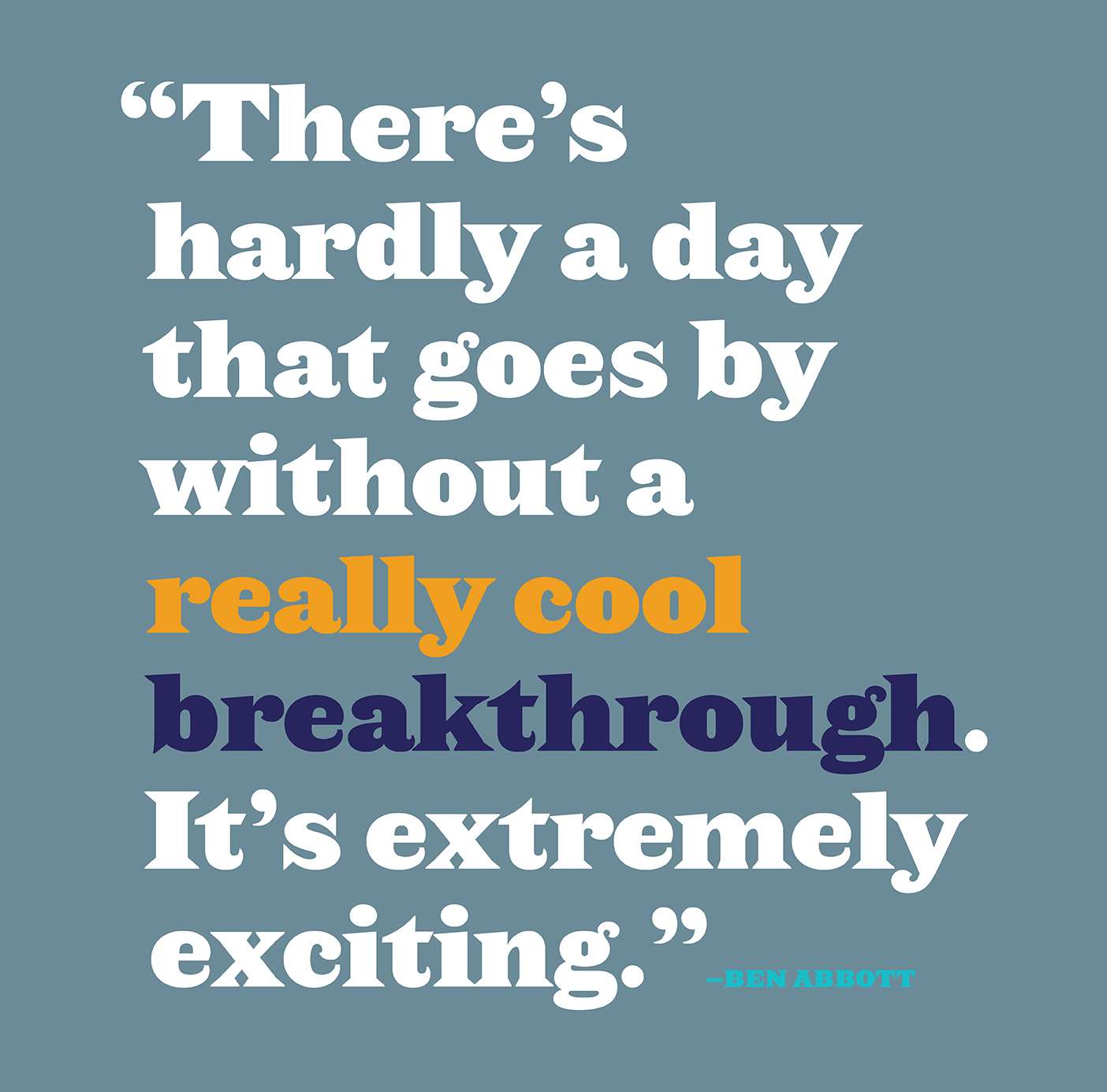
Are We Toast?
Hope for the Environment
Can we be optimistic about the environment? BYU environmental scientist Ben Abbott says yes, and he points to recent history.
Before 1972, 90 percent of US waterways were not approved for recreation or the consumption of fish due to pollution. The Cuyahoga River in Ohio carried so much petroleum waste that it actually caught fire. But with the Clean Water Act and tightened regulations for manufacturing waste and sewage treatment, the waters have cleared. “You can now eat fish out of the Cuyahoga River,” says Abbott.
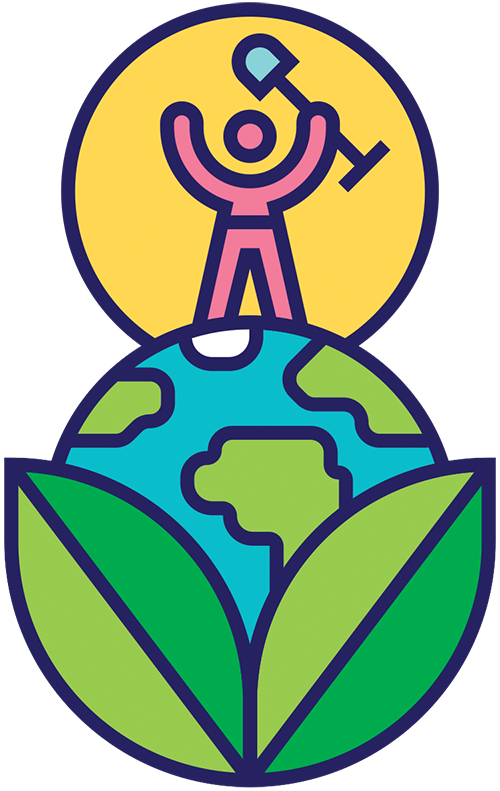
Or take the gaping hole in the atmosphere’s ozone layer that was killing crops and increasing cancer. In 1987 every country on the planet banned ozone-depleting refrigerants, and the hole almost immediately stopped growing and has begun to heal. “Individual countries, individual corporations, individual citizens collaborated together to solve this,” says Abbott.
The same could be said for the removal of toxic lead from gasoline or the cap-and-trade system that reduced coal emissions and acid rain. Examples like these bolster Abbott’s faith in humanity’s ability to address looming environmental challenges.
With respect to climate change, Abbott is encouraged by warp-speed gains in relevant tech. In 30 years the cost of producing solar photovoltaic energy has decreased 99 percent, making the green energy source now the cheapest form of energy to install. “It’s astounding,” he says. Couple that with improvements in battery technologies—which are 95 percent cheaper to produce than 10 years ago and ever less reliant on pollutants—and viable replacements for coal- and gas-powered electricity are quickly becoming a reality. Not to mention the rise of the electric vehicle or other climate-friendly developments. “There’s hardly a day that goes by without a really cool breakthrough,” says Abbott. “It’s extremely exciting.”
A Safer Society
Hope for Sexual Safety
Sexual aggression, violence, and underreporting have been problems in our world as far as we can look back, and they’re not likely to disappear entirely, acknowledges BYU Title IX coordinator Tiffany Turley. Even so, she says, “those of us in this field definitely have reasons for optimism about better days to come. Our society seems to be progressing in important ways, and data reflect that these issues have generally decreased over the past 20 years.”
Turley credits broader awareness and heightened interest in human rights and equality. And she notes that support for victims, particularly those in vulnerable populations, has increased as reporting systems and processes have improved. Add to that forensic advances that contribute to increased prosecution of sexual crimes in the criminal-justice system. “All of this gives us hope that the efforts we’re making as practitioners and simply good community citizens are working.”
Proteins and Sea Sponges
Hope for Cancer Treatments
Is there a cancer panacea anywhere on the horizon? Not likely, says Steven L. Castle (BS ’95), chemistry professor and director of BYU’s Simmons Center for Cancer Research.
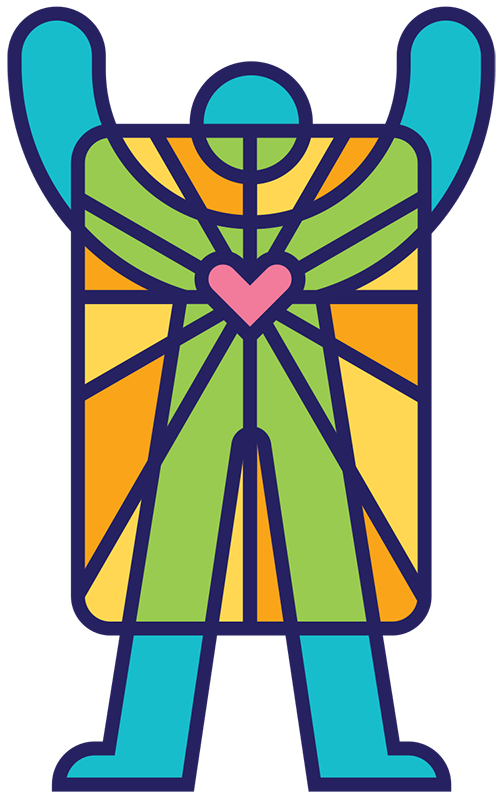
Instead, Castle’s hope is in “next-generation cancer treatments” that can shrink tumors while minimizing brutal side effects. The key is pinpointing targets—usually proteins found only in cancer cells—and creating compounds that selectively obliterate these proteins or block their cancer-causing actions.
Molecular biologists the world over are identifying target proteins, while organic chemists are looking to nature for compounds that can destroy them. Castle’s own lab just synthesized the molecule yaku’amide, which comes from a sea sponge, to lay the groundwork for a future cancer drug. He also points to Simmons Center alum Erik J. Hicken (PhD ’05), who helped discover a way to drug a cancer protein once thought “undruggable.” After promising early trials, the FDA gave the drug “breakthrough therapy” status to expedite its development.
With the speed at which tumors mutate, “we will always be battling cancer,” Castle says. “But with these new tools, we will be able to treat it much more effectively.”
Scrolling for Good
Hope for Social Media
It’s hard not to cringe when you spot yet another teen nose-down in a smartphone. But fears about social media stunting minds and rotting relationships may be “a little overblown,” says BYU media researcher Sarah M. Coyne.

“Where I’m hopeful is that as researchers, we’re starting to really look at things like context around social-media use,” says Coyne, a professor of child development and family life. Her own research suggests that teen girls who spend hours online daily, teens who already have poor mental health and weak relationships, and those who mindlessly scroll are at greater risk for negative effects like depression and loneliness. On the other hand, she found that active, involved participation on social media actually reduces these symptoms.
Coyne expects that science will illuminate best practices for social media “that will improve [teens’] mental health, improve their connections, and improve their relationships.”
Used wisely, she says, social media “allows you to empathize, to serve, to share beliefs about Christ, to feel less marginalized. We lose sight of the possibility of goodness when we just focus in on the negative.”
Vaccine Revolution
Hope for the Fight Against Infectious Disease
BYU immunologist Brian D. Poole (BS ’99) sees a path back to pre-pandemic “normal life”—and new hope for fighting other diseases—in the mRNA vaccines developed against COVID-19.
“Within one year we had up to five different vaccines that are effective,” says the microbiology and molecular biology professor. “That’s amazing. We’re talking about literal miracles.” The technology behind these mRNA vaccines was ready to go right when the world needed it.
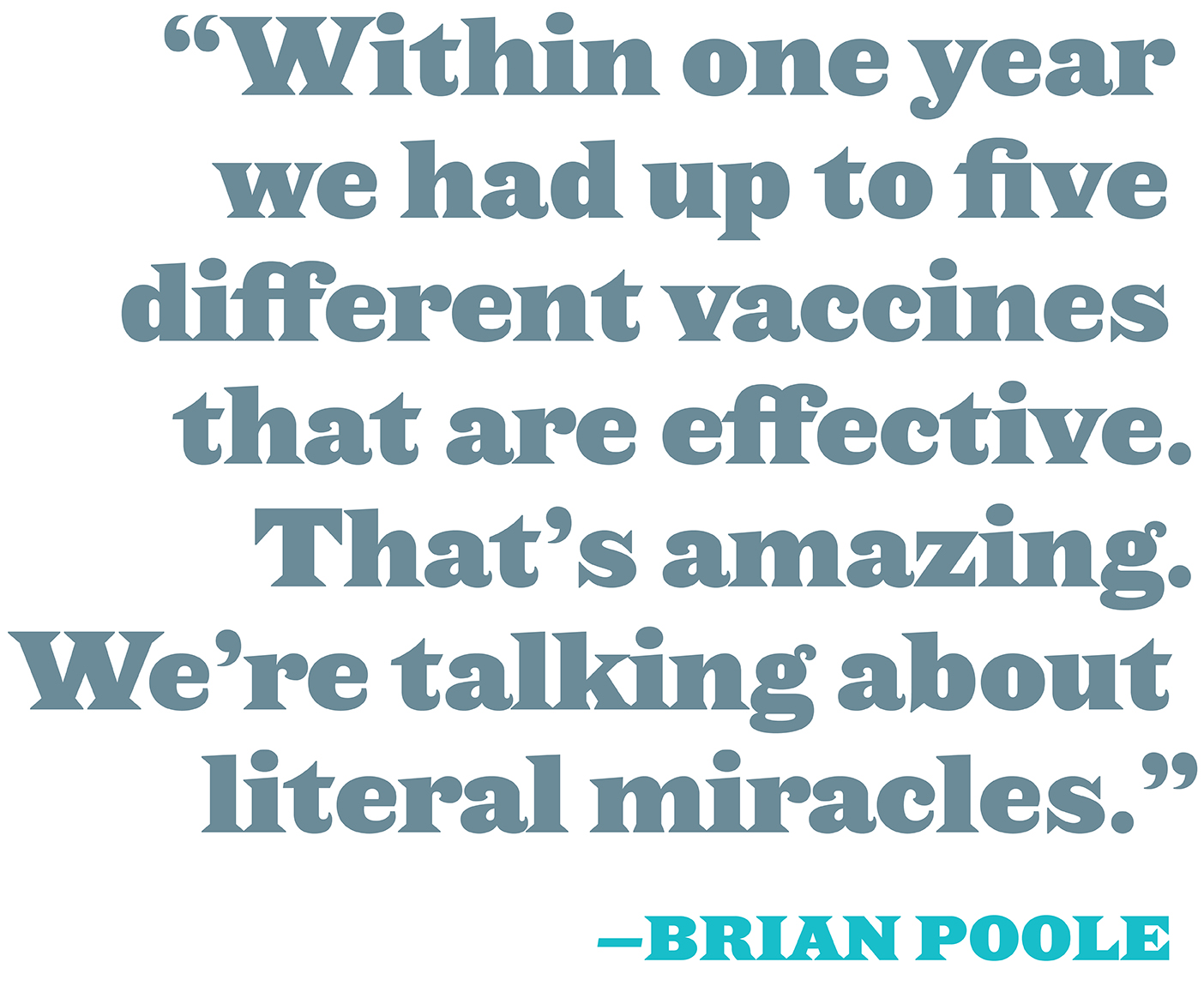
“These vaccines have been tested more than any other vaccines,” Poole says. The efficacy of COVID-19 vaccines offer evidence that mRNA technology works, so much so that Poole foresees a “revolution in vaccine technology.”
mRNA vaccines are “just so user friendly,” he says. “You can synthesize the RNA in the lab so it’s adaptable to almost every type of virus that you can think of.” One of those viruses that researchers are now targeting? HIV. “All of the other HIV vaccines that have ever been tried have failed horribly, but maybe this one will work,” Poole says. “And if it does, that could erase the disease from our last pandemic.”
Filling the Family Tree
Hope for Family History
You know that family pedigree tree that pulls up when you log into FamilySearch? Economics professor Joseph P. Price (BA ’03) can see a day, not too far in the future, when that tree is filled—leaves, twigs, and all.
“I think it’s very likely that we will gather the vast majority of people who have lived on earth together into a large, interconnected family tree,” Price says.
Price heads BYU’s Record Linking Lab, where he and his students create machine-learning tech that lets them analyze economic trends in historical records—and make it easier for more people to add records and names to the family tree at familysearch.org.
“I think the United States will be complete within the next three years, and there’s several European countries that will be right behind it,” Price says. “Those are real people,” he adds. “Every time I put someone on the tree, I feel this immense amount of gratitude from them because they want to be gathered. It is the most important work of this generation—to gather together God’s family.”
Not That Different

Hope for Political Union
The neighbors down the street who still have yard signs touting their favorite 2020 candidate—yes, the one you didn’t vote for—might not actually be that different from you. Rhetoric about Americans being “torn apart” and “deeply divided” politically lacks in nuance, says BYU political-science professor Jeremy C. Pope (BA ’97).
“There’s more unity in the public than we think there is,” says Pope, who’s published two books on American political division. “There are areas of disagreement—it’s just that we tend to think that disagreement is universal, and it’s not.”
He mentions an example from pandemic policy preferences: Democrats and Republicans showed almost equal support for financial relief for small businesses and families and equal disapproval for delaying elections. And even in some areas where Americans are indeed divided across party lines—raising minimum wages, for example—Pope notes that the division doesn’t run as deep as pundits and news coverage might lead us to think: “The Republicans would like to raise it to something like $12 an hour,” Pope says. “And Democrats would like to raise it to $15. Are they different? Yes, but both of those are substantially higher than the minimum wages right now.”
His hope for overcoming that conflict is in looking beyond party labels to what we can agree on.
“There’s a lot of evidence that people have come to dislike one another in terms of which party they support,” Pope says. “But once you realize that Republicans and Democrats probably don’t have nearly as divergent opinions, across all issues, as you might think, that should temper your dislike. It will make you like your neighbors more.”

Fastening Family Ties
Hope for the Family
BYU family-life professor Alan J. Hawkins (BS ’79, MOB ’84) has plenty of worries about the place of the traditional family in society—fewer people marrying, a fertility rate plummeting worldwide, and religiosity (with its support for family life) trending down with younger generations.
But the news isn’t all grim, he says. The marriages that are happening are “stronger and higher in quality than they ever have been,” he says, noting that divorce rates have been tumbling for 40 years. And the percentage of children born to unwed parents—which had hovered at 42 percent for a quarter century—finally seems to be declining, and it’s not due to abortions, which are also on the decline. “Pragmatically,” he says, “people understand that unwed childbearing is not a smart move for children or adults.”
Feedback Send comments on this article to magazine@byu.edu.


